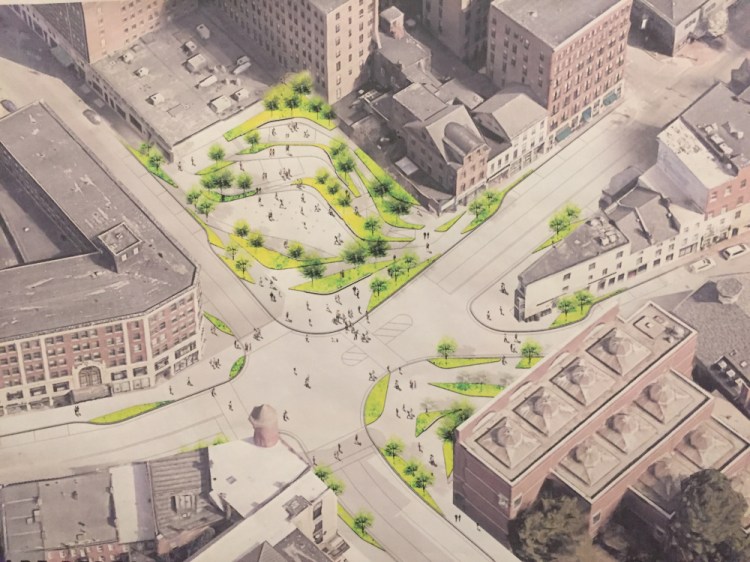A conceptual design for Congress Square Park and the surrounding intersection showed sloping levels, a performance stage facing traffic and a plaza in front of the Portland Museum of Art that would eliminate the cut-through from High Street to Free Street.
Designers from Philadephia-based WRT unveiled the plans at a public forum Thursday at the Westin hotel, next to the park at the corner of High and Congress streets. Nearly 100 people attended the meeting, many of whom asked questions and offered feedback the designers said they would take into consideration as they solidify the plan.
While some asked about trash cans, bike racks and the materials that would be used, the designers said they had not gotten into that level of detail in their planning. They also did not have estimates of the cost or time frame for implementing the plan, which would rely on fundraising.
The effort to remake Congress Square grew out of a controversial move by the City Council in 2013 to sell a portion of Congress Square Park to an out-of-state developer looking to building an event center. The proposed sale prompted residents to organize, protest and ultimately overturn the sale through a citywide referendum that also added protections to all of the city’s parks.
The rendering presented Thursday showed an aerial view of the intersection with the main park designed as four levels, starting at the sidewalk, sloping down into a larger space that could contain an interactive water feature, such as jets or a mist where children can play. That level also could be used for the popular dancing classes that are already held in the park, as could a smaller level that slopes up from there.
The highest part of the park would be the back corner, which would act as a stage facing out into the intersection.
Throughout the park, as well as in the plaza in front of the museum and all corners of the intersection, were islands of landscaping that would include trees and other plants that would transform from season to season.
Also addressed at the meeting was the artwork by Sarah Sze, a New York City artist who has connections to Maine and is being paid $75,000 for her work. Although travel problems prevented her from getting to the meeting, her colleague, David Ramirez, said she planned to install three sculptures throughout the park that would blend into the design, appearing as if they existed before the park did and that it had grown around them. He would not be specific about what the sculptures would look like.
Overall, people who attended the meeting seemed excited by the design.
“I like the plan a lot,” said Pat O’Donnell, a nearby resident and the treasurer of the Friends of Congress Square Park, a nonprofit that led efforts to save the park from development. “I like the use of space. I like the amount of greenery.”
Grace Braley, another Portland resident who attended the meeting, said she thought the design looked nice, but believes it wouldn’t be feasible to do everything presented, such as the water feature, while also having areas for eating and dancing, which the public wants most.
“They’ve got to prioritize,” she said.
Keiko Cramer of WRT, which is being paid nearly $80,000 for its work, said she felt the biggest concerns from the public were about the design of the park in relation to the street. The firm has considered making parts or all of the sidewalk flush with the roadway. Also, the plan showed a traffic signal on Congress Street pushed back to the Hay Building at the top of Free Street, creating a more open intersection for pedestrians to travel.
Changes to the curbs and sidewalks would need to be approved by the Maine Department of Transportation.
Cramer said nothing about the meeting surprised her, except for how many people showed up on such a cold night.
Send questions/comments to the editors.




Comments are no longer available on this story